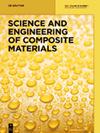Development of Mg-based metal matrix biomedical composites for acicular cruciate ligament fixation by reinforcing with rare earth oxide and hydroxyapatite – A mechanical, corrosion, and microstructural perspective
IF 1.6
4区 材料科学
Q3 Materials Science
引用次数: 0
Abstract
Abstract This study provides an insight into the synthesis of high-strength and corrosion-inhibiting Mg-based biodegradable implant material by the addition of rare earth oxide material for acicular cruciate ligament reconstruction applications. The matrix has been reinforced with a naturally occurring mineral, hydroxyapatite (Ca5(PO4)3OH) and rare earth oxide, neodymium oxide (Nd2O3), in different concentrations. The mechanical response has been assessed by analyzing the samples’ microhardness, ultimate compressive, and tensile strength. In contrast, the corrosion rates were calculated using phosphate buffer saline solution by using different techniques under suitable physiological conditions. The microstructure characterization has been carried out by field emission scanning electron microscope, electron dispersive spectroscopy, optical microscopy, and X-ray diffraction techniques. Moreover, the surface properties of the composites were assessed using surface roughness and contact angle measurements. The sample showed maximum hardness at a concentration of 1.5% rare earth oxide. Moreover, the highest ultimate compressive and tensile strength followed the same order, i.e., 1.5% > 2% > 1%. In addition, the microstructure analysis revealed a refined microstructure and the formation of secondary intermetallic phases. Resistance to dislocation and grain growth barricading were the prominent features highlighted in the study for enhanced mechanical and corrosion properties. Moreover, the hydrogen evolution was lower for Mg–HA–1.5Nd2O3 samples, which was a clear indication of a reduced corrosion rate.用稀土氧化物和羟基磷灰石增强固定十字韧带的镁基金属基生物医学复合材料的开发——从力学、腐蚀和微观结构的角度
摘要本研究通过添加稀土氧化物材料合成高强度、耐腐蚀的镁基生物可降解植入材料,用于针状交叉韧带重建应用。基质已经用不同浓度的天然矿物羟基磷灰石(Ca5(PO4)3OH)和稀土氧化物钕氧化物(Nd2O3)增强。通过分析样品的显微硬度、极限抗压强度和抗拉强度来评估机械响应。相反,在合适的生理条件下,通过使用不同的技术,使用磷酸盐缓冲盐水溶液计算腐蚀速率。通过场发射扫描电子显微镜、电子色散光谱、光学显微镜和X射线衍射技术对其微观结构进行了表征。此外,使用表面粗糙度和接触角测量来评估复合材料的表面性能。样品在1.5%的稀土氧化物浓度下显示出最大硬度。此外,最高极限抗压强度和抗拉强度遵循相同的顺序,即1.5%>2%>1%。此外,微观结构分析揭示了细化的微观结构和次生金属间相的形成。抗位错和晶粒生长阻挡是研究中强调的增强机械和腐蚀性能的突出特征。此外,Mg–HA–1.5Nd2O3样品的析氢量较低,这清楚地表明腐蚀速率降低。
本文章由计算机程序翻译,如有差异,请以英文原文为准。
求助全文
约1分钟内获得全文
求助全文
来源期刊

Science and Engineering of Composite Materials
工程技术-材料科学:复合
CiteScore
3.10
自引率
5.30%
发文量
0
审稿时长
4 months
期刊介绍:
Science and Engineering of Composite Materials is a quarterly publication which provides a forum for discussion of all aspects related to the structure and performance under simulated and actual service conditions of composites. The publication covers a variety of subjects, such as macro and micro and nano structure of materials, their mechanics and nanomechanics, the interphase, physical and chemical aging, fatigue, environmental interactions, and process modeling. The interdisciplinary character of the subject as well as the possible development and use of composites for novel and specific applications receives special attention.
 求助内容:
求助内容: 应助结果提醒方式:
应助结果提醒方式:


